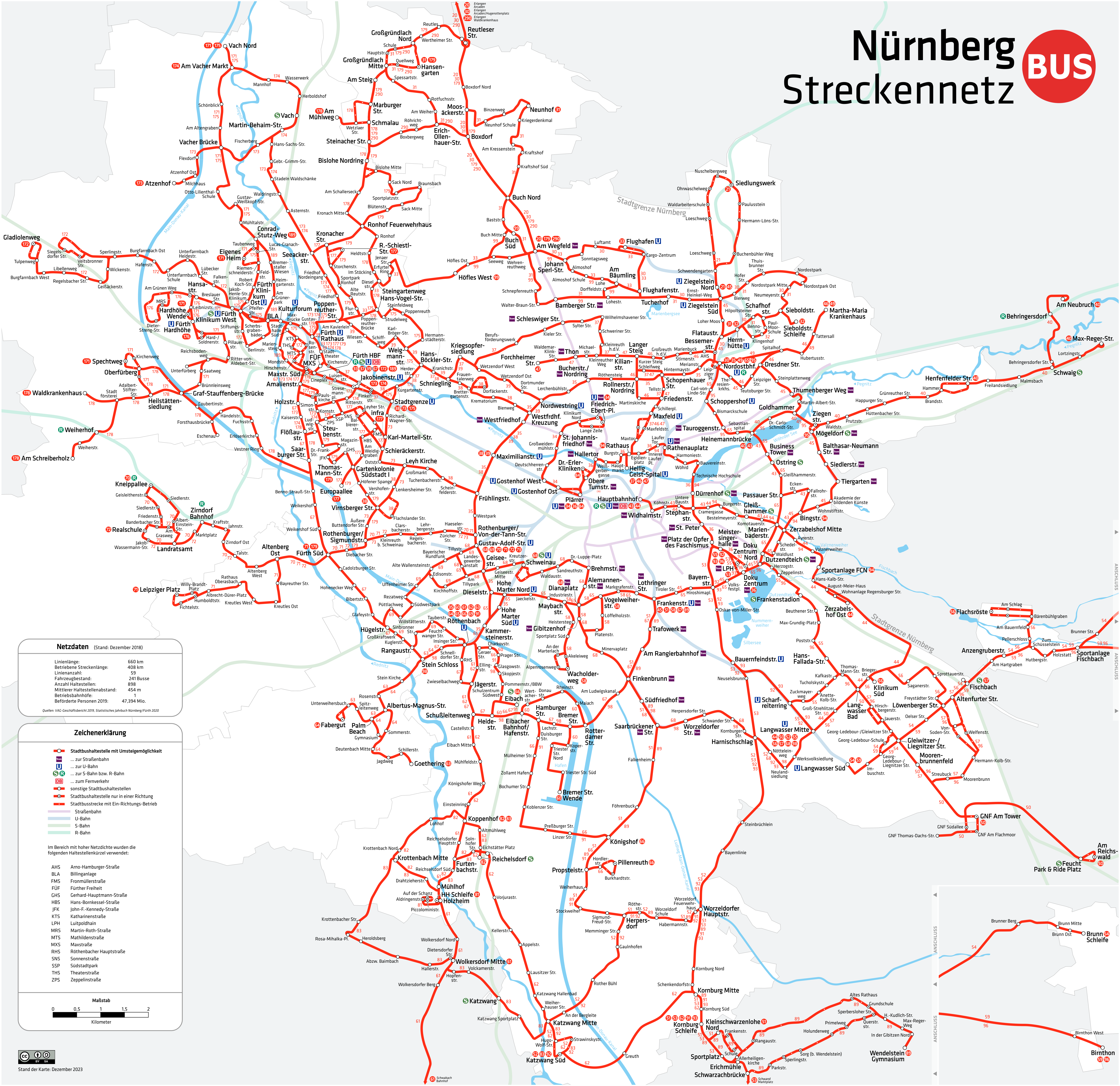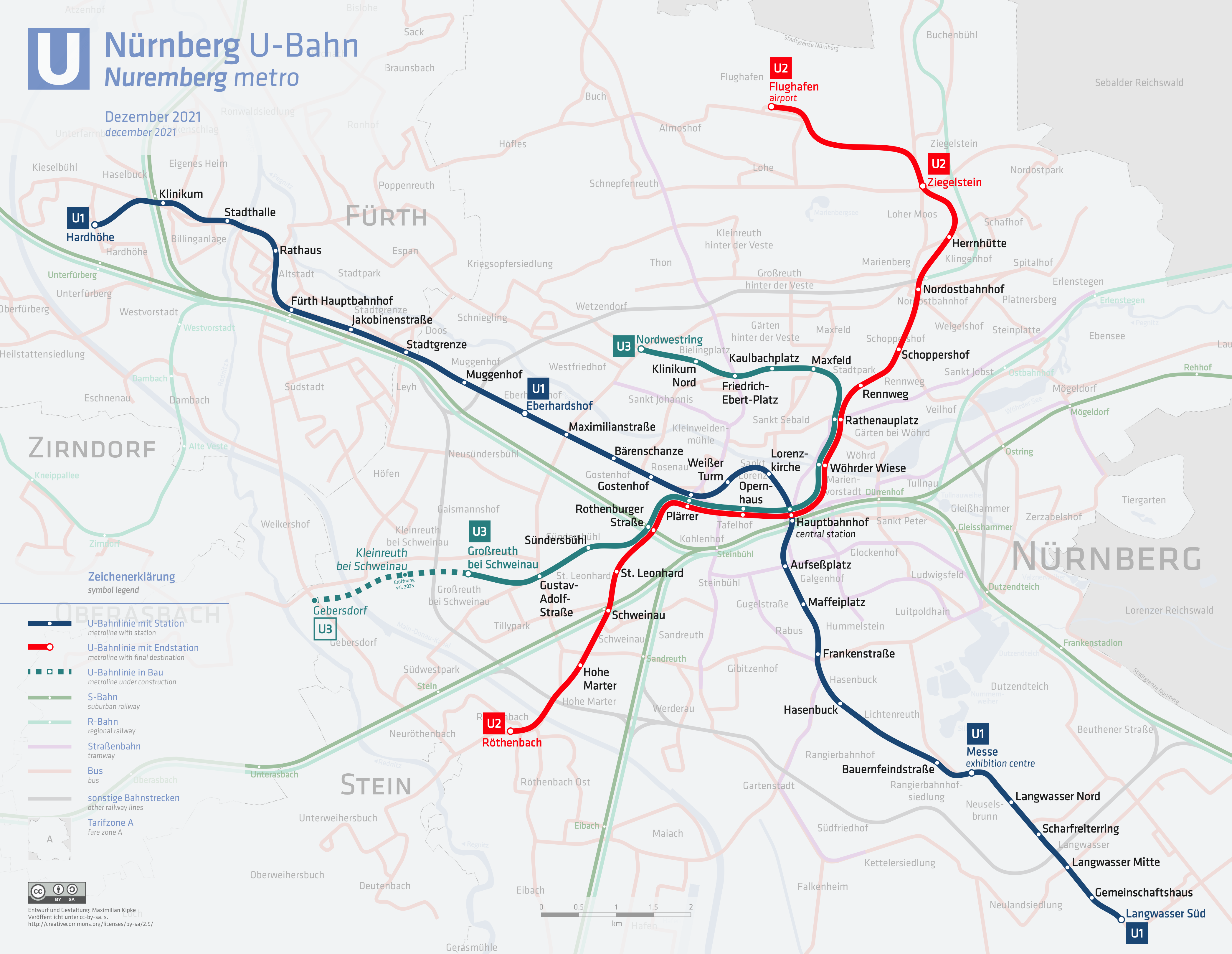|
VAG Class DT2
The VAG Class DT2 is an electric multiple unit (EMU) train type operated by the Verkehrs-Aktiengesellschaft Nürnberg on the Nuremberg U-Bahn system. It is a derivative of the MVG Class B, in service on the Munich U-Bahn since 1981. Formation Every DT2 train consists of two permanently-coupled cars, forming a twin-unit. Interior Seating accommodation consists of transverse seating bays with ergonomically shaped seats. The interior features less seating spaces than the interior of the VAG Class DT1, in order to provide more space for luggage and standing passengers. U-Bahn Nürnberg DT 551-552 Flughafen Innen.jpg, Interior view Technical specifications The design is derived from the MVG Class B. The car bodies are made out of aluminium, and the trains are powered by three-phase motors. Unlike its predecessor DT1 and the related Class B, the three-phase motors of the DT2 are arranged transverse to the direction of travel. Besides the power supply by contact shoes, every u ... [...More Info...] [...Related Items...] OR: [Wikipedia] [Google] [Baidu] |
MAN SE
MAN SE (abbreviation of ''Maschinenfabrik Augsburg-Nürnberg'', ) was a manufacturing and engineering company based in Munich, Germany. Its primary output was commercial vehicles and diesel engines through its MAN Truck & Bus and MAN Latin America divisions, and participation in the manufacturer Sinotruk. MAN SE was majority-owned by Traton, the heavy commercial vehicle subsidiary of automaker Volkswagen AG, until August 2021 when Traton completed a squeeze out of all remaining shareholders and formally merged MAN SE into Traton SE, meaning the former subsidiaries of MAN SE were now directly owned by Traton, and MAN SE ceased to exist. History Foundation MAN traces its origins back to 1758, when the "St. Antony" ironworks commenced operation in Oberhausen, as the first heavy-industry enterprise in the Ruhr region. In 1808, the three ironworks "St. Antony", "Gute Hoffnung" (English: "Good Hope"), and "Neue Essen" (English: "New Forges") merged, to form the Hüttengewerks ... [...More Info...] [...Related Items...] OR: [Wikipedia] [Google] [Baidu] |
Munich U-Bahn
The Munich U-Bahn (german: U-Bahn München) is an electric rail rapid transit network in Munich, Germany. The system began operation in 1971, and is operated by the municipally owned Münchner Verkehrsgesellschaft (MVG; Munich Transport Company). The network is integrated into the Münchner Verkehrs- und Tarifverbund (MVV; Munich Transport and Tariff Association) and interconnected with the Munich S-Bahn. The U-Bahn currently comprises eight lines, serving 96 stations (100 stations if four interchange stations with separate levels for different lines are counted twice), and encompassing of routes. Current routes There are eight lines: The network has of active route, and 100 stations. In 2014, 390 million passengers rode the U-Bahn. The trains operate at speeds up to , which is the top speed among German U-Bahns. There is no continuous operation during the night (break from 1 to 4 am, 2 to 4 am on weekends) except on special occasions such as New Year's Eve. Currently, ... [...More Info...] [...Related Items...] OR: [Wikipedia] [Google] [Baidu] |
Siemens
Siemens AG ( ) is a German multinational conglomerate corporation and the largest industrial manufacturing company in Europe headquartered in Munich with branch offices abroad. The principal divisions of the corporation are ''Industry'', ''Energy'', ''Healthcare'' (Siemens Healthineers), and ''Infrastructure & Cities'', which represent the main activities of the corporation. The corporation is a prominent maker of medical diagnostics equipment and its medical health-care division, which generates about 12 percent of the corporation's total sales, is its second-most profitable unit, after the industrial automation division. In this area, it is regarded as a pioneer and the company with the highest revenue in the world. The corporation is a component of the Euro Stoxx 50 stock market index. Siemens and its subsidiaries employ approximately 303,000 people worldwide and reported global revenue of around €62 billion in 2021 according to its earnings release. History 1847 to ... [...More Info...] [...Related Items...] OR: [Wikipedia] [Google] [Baidu] |
Three-phase
Three-phase electric power (abbreviated 3φ) is a common type of alternating current used in electricity generation, Electric power transmission, transmission, and Electric power distribution, distribution. It is a type of polyphase system employing three wires (or four including an optional neutral return wire) and is the most common method used by electrical grids worldwide to transfer power. Three-phase electrical power was developed in the 1880s by multiple people. Three-phase power works by the voltage and currents being 120 degrees phase shift, out of phase on the three wires. As an AC system it allows the voltages to be easily stepped up using transformers to high voltage for transmission, and back down for distribution, giving high efficiency. A three-wire three-phase circuit is usually more economical than an equivalent two-wire Single-phase electric power, single-phase circuit at the same line to ground voltage because it uses less conductor material to transmit a giv ... [...More Info...] [...Related Items...] OR: [Wikipedia] [Google] [Baidu] |
Aluminium
Aluminium (aluminum in American and Canadian English) is a chemical element with the symbol Al and atomic number 13. Aluminium has a density lower than those of other common metals, at approximately one third that of steel. It has a great affinity towards oxygen, and forms a protective layer of oxide on the surface when exposed to air. Aluminium visually resembles silver, both in its color and in its great ability to reflect light. It is soft, non-magnetic and ductile. It has one stable isotope, 27Al; this isotope is very common, making aluminium the twelfth most common element in the Universe. The radioactivity of 26Al is used in radiodating. Chemically, aluminium is a post-transition metal in the boron group; as is common for the group, aluminium forms compounds primarily in the +3 oxidation state. The aluminium cation Al3+ is small and highly charged; as such, it is polarizing, and bonds aluminium forms tend towards covalency. The strong affinity tow ... [...More Info...] [...Related Items...] OR: [Wikipedia] [Google] [Baidu] |
VAG Class DT1
The VAG Class DT1 (colloquially called "Pegnitzpfeil") is an electric multiple unit (EMU) train type operated by the Verkehrs-Aktiengesellschaft Nürnberg on the Nuremberg U-Bahn system since its opening in 1972. It is a derivative of the MVG Class A, in service on the Munich U-Bahn since 1971. Formation Every DT1 train consists of two permanently-coupled cars, forming a twin-unit. The trains are equipped with automatic couplers, enabling operation of up to two units together to form a four-car train. Interior Seating accommodation consists of transverse seating bays. Passengers can look into the adjacent car through two windows in the inner car end. U-Bahn Nürnberg DT 453-454 Fürth-Hardhöhe Innen.jpg, Interior view Technical specifications The design is derived from the MVG Class A. Differences include a magnetic track brake system, that is missing from Munich's Class A trains. The car bodies are made out of aluminium, and the trains are powered by direct current mot ... [...More Info...] [...Related Items...] OR: [Wikipedia] [Google] [Baidu] |
Twin-unit
A twin unit or twinset is a set of two railroad cars or locomotives which are permanently coupled and treated as if they were a single unit. A twinset of cars or coaches can also be called a twin car. In US passenger railroad parlance, twin units are also known as married pairs. On passenger railroads, light rail, and monorail services, married pairs may have machinery necessary for full operation of the cars split between them. Items that are typically shared include transformers, motor controllers, dynamic braking grids, cabs, current collectors, batteries, and air compressors. This provides significant savings in both cost of equipment and weight, which increases performance and decreases energy consumption. The cost of operating such a pair may be slightly higher when the extra car in such a pair is not needed to meet level-of-service demands at a particular time. See also * Cow-calf In rail transport, a cow-calf (also cow and calf) locomotive is a set of switcher- ... [...More Info...] [...Related Items...] OR: [Wikipedia] [Google] [Baidu] |
MVG Class B
The MVG Class B is an electric multiple unit (EMU) train type operated by the Münchner Verkehrsgesellschaft on the Munich U-Bahn system. The prototypes were delivered in 1981, and the full-production units from 1987. A derivative of the Class B, the VAG Class DT2, is in service on the Nuremberg U-Bahn system. Formation Every Class B train consists of two permanently-coupled cars, forming a twin-unit. The car at the northern end is numbered 6xxx, while the car at the southern end is numbered 7xxx. The trains are equipped with automatic Scharfenberg couplers, enabling operation of up to three units together to form a six-car train. The Class B was delivered in three batches: *B1.4: prototype units, fleet numbers 494–499, delivered in 1981 *B2.7: full production units, fleet numbers 501–535, delivered from 1987 *B2.8: full production units, fleet numbers 551–572, delivered from 1994 The B2.8 series differs from the earlier series, as they have flip-dot display d ... [...More Info...] [...Related Items...] OR: [Wikipedia] [Google] [Baidu] |
Verkehrs-Aktiengesellschaft Nürnberg
The ''Verkehrs-Aktiengesellschaft Nürnberg'' (VAG; Nuremberg Transport Company) is the municipal company responsible for operating the U-Bahn, trams, and buses throughout the city of Nuremberg, in the state of Bavaria, Germany. VAG is a wholly owned subsidiary of ''Städtischen Werke Nürnberg'' (''Nuremberg Municipal Works''), and a member of the ''Verkehrsverbund Großraum Nürnberg'' (VGN; Integrated Transport Association of Greater Nuremberg). History Nürnberg-Fürther Straßenbahn On April 12, 1881, entrepreneur Heinrich Alfes from Bremen received a charter for the manufacture and operation of a ''Pferdebahn'', a horse-drawn streetcar. The first line began operation on August 25, 1881, on the route Staatsbahnhof (current Nuremberg Hauptbahnhof) - Lorenzkirche - Plärrer - Bauerngasse. In 1883, the enterprise was reorganized into a private Aktiengesellschaft with the name Nürnberg-Fürther Straßenbahn-Gesellschaft, or Nuremberg-Fürth Streetcar Company. The company e ... [...More Info...] [...Related Items...] OR: [Wikipedia] [Google] [Baidu] |
Nuremberg U-Bahn
The Nuremberg U-Bahn is a rapid transit system run by ''Verkehrs-Aktiengesellschaft Nürnberg'' (VAG; Nuremberg Transport Corporation), which itself is a member of the ''Verkehrsverbund Großraum Nürnberg'' (VGN; Greater Nuremberg Transport Network). The Nuremberg U-Bahn is Germany's newest metro system, having begun operation in 1972, although the Nuremberg-Fürth route (U1) uses part of the right of way of the Bavarian Ludwig Railway, Germany's first passenger railway opened in 1835. The current network of the U-Bahn is composed of three lines, serving 49 stations, and comprising of operational route, making it the shortest of the four metro systems in Germany, behind Berlin, Hamburg and Munich. In 2008, driverless and fully automated trains were introduced on the new U3 line, making it Germany's first automatic U-Bahn line. History Plans for a metro in Nuremberg go back to 1925, when Nuremberg graduate engineer Oscar Freytag spoke out in favor of building a metro under F� ... [...More Info...] [...Related Items...] OR: [Wikipedia] [Google] [Baidu] |
Electric Multiple Unit
An electric multiple unit or EMU is a multiple-unit train consisting of self-propelled carriages using electricity as the motive power. An EMU requires no separate locomotive, as electric traction motors are incorporated within one or a number of the carriages. An EMU is usually formed of two or more semi-permanently coupled carriages, but electrically powered single-unit railcars are also generally classed as EMUs. The great majority of EMUs are passenger trains, but versions also exist for carrying mail. EMUs are popular on commuter and suburban rail networks around the world due to their fast acceleration and pollution-free operation. Being quieter than diesel multiple units (DMUs) and locomotive-hauled trains, EMUs can operate later at night and more frequently without disturbing nearby residents. In addition, tunnel design for EMU trains is simpler as no provision is needed for exhausting fumes, although retrofitting existing limited-clearance tunnels to accommodate the ... [...More Info...] [...Related Items...] OR: [Wikipedia] [Google] [Baidu] |







